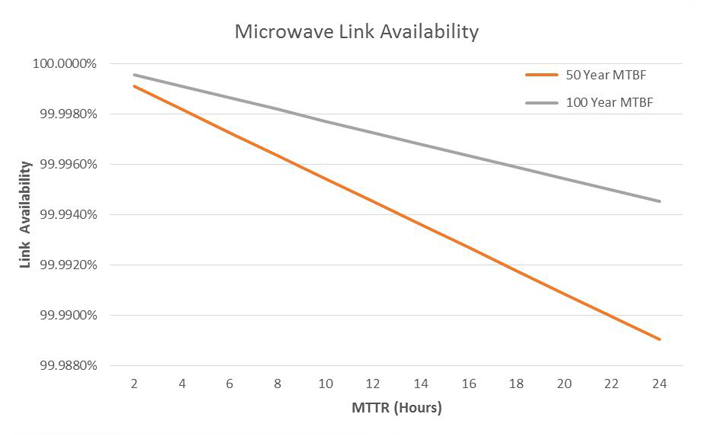Building a Reliable Microwave Backhaul Network with Harmony Products

Backhaul network reliability is always a critical concern for operators, especially for those more accustomed to fiber and now considering microwave solutions. The three key elements to microwave network availability are equipment reliability, protection, and path reliability. DragonWave’s Harmony products provide industry-leading capabilities that address each of these issues.
Equipment Reliability - The equipment reliability of DragonWave’s Harmony microwave radios represents best-in-class performance, with typical MTBFs of 50 to 100 years between failures. As shown in the graph below, this can deliver an unprotected equipment link availability of 99.999%, if the Mean Time To Repair (MTTR) is 4 hours or better. If the MTTR is not low enough to deliver the desired link availability, equipment redundancy needs to be considered. The link availability due to equipment is independent of link capacity or link length, and is therefore very easy to engineer and determine in advance.

Protection – DragonWave’s Harmony products offer a number of equipment protection options. The first form is basic 1+1 equipment redundancy, which protects against a radio failure in a link. This can be used to deliver very high availabilities, or to improve availabilities in the case of high mean time to repair. The second form of microwave protection is ring or mesh protection. This provides hardening against equipment failures, as well as against any path fade from rain. However, it is often difficult to deploy ring and mesh protection, as the capacity has to be shared across all of the links, and often connectivity required for a ring or mesh is not available. The Harmony product line also provides 2:0 capabilities, which provides double capacity during regular operation, and then single capacity during an equipment failure. When the capacity is reduced, the system prioritizes traffic to deliver the highest priority traffic first.
Path Availability – The major contributor to link availability is path availability. Link availability is primarily affected by rain, which is well characterized for all areas of the world. Higher rain averages require extra rain fade margin to compensate for expected loss due to rain. Link availability is determined based on link length, microwave system gain for the operating mode, antenna gain, and the rain rate. The link length for a desired path is something that usually is fixed, as when a site requires connectivity there is only one potential site to connect it to. In addition, rain rate can be altered because it is determined by the location of the path. So, typically, the only way an operator can improve link length has been by increasing the antenna size. In many cases, however, there are tower restrictions due to wind loading, so the operator may not be able to install the desired antenna size. As a result one may have to accept lower link availability, and as a consequence deal with poor network reliability.
Delivering Network Reliability with System Gain and Harmony Automatic Adaptive Modulation
DragonWave’s Harmony microwave systems have been introduced with higher output power, resulting in up to 10dB additional system gain. With this additional system gain, a service provider can significantly improve link availability without having to increase antenna size, or compromise on link capacity. Keeping all other parameters the same, this system gain improvement can increase link availability on average from 99.995% to 99.999%, while delivering high capacity and keeping antenna sizes small. What’s more, all of the Harmony systems support Automatic Adaptive Modulation, allowing the system to switch to a lower modulation and capacity during a rain fade, and maintaining high system availability.

Good analysis, very clear.